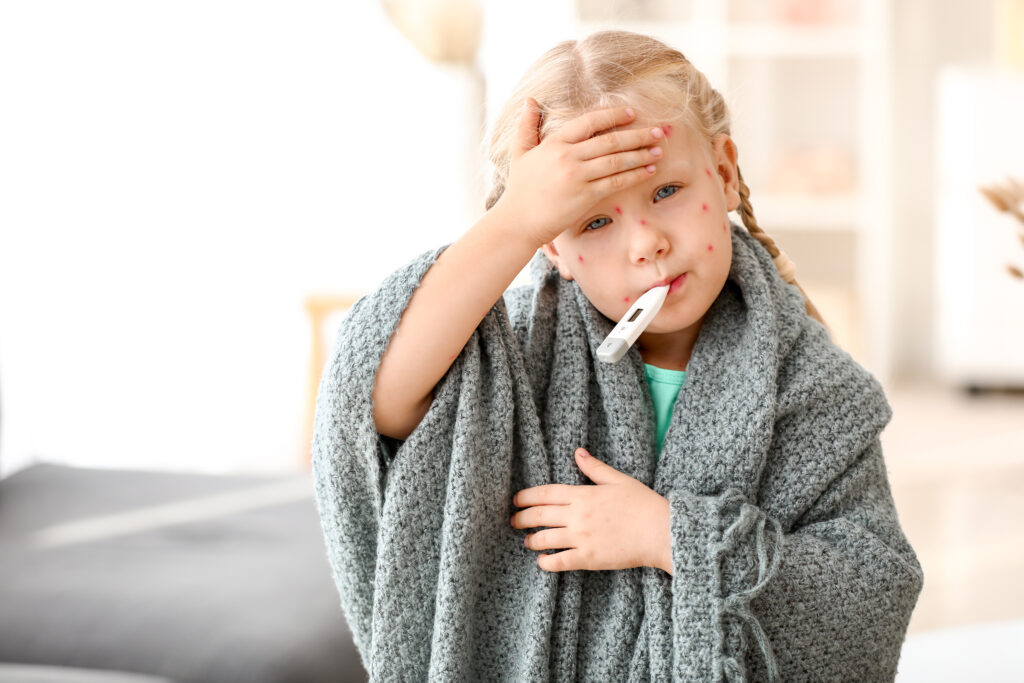
Before the introduction of a vaccine in 1995, almost every American child caught a case of chickenpox. Since most people develop immunity after one round of infection, parents would even group together their healthy children and sick children to expose them to the illness in one fell swoop. However, after the chickenpox vaccination hit the U.S., infections, hospitalizations, and deaths dropped dramatically.
Nowadays, thanks to immunization in early adolescence, this viral infection is far less common. Rates of infection have dropped from 4 million yearly cases to under 150,000. However, it is still possible to be impacted by chickenpox, especially for those who are unvaccinated or have never had the illness before. What exactly causes chickenpox? What are the symptoms? And how can preventative measures save lives?
What Causes Chickenpox?
The symptoms of chickenpox are caused by a virus known as the varicella-zoster virus. This virus is highly contagious and often impacts young children, who can easily spread the illness in daycares and schools. However, any age can catch it, especially those who are unvaccinated or have not had the virus before.
Fortunately, chickenpox is a fairly mild condition in healthy kids. Symptoms are often worse in adults, though there tends to be a limited concern for complications. Although the development of a vaccine has led to a lower occurrence of chickenpox, it is still possible to catch this virus today. Understanding the symptoms of chickenpox can help you get effective treatment, recover more quickly, and prevent the illness from spreading within your community.
Symptoms of Chickenpox
The hallmark symptom of chickenpox is a spotted rash. This begins as clusters of red dots that develop blisters on top, then progressively grow extremely itchy. After a day or two, these blisters pop open, leak fluid, and develop a crust. Within a few days, these wounds heal. It's possible to go through cycles of developing new rounds of spots, so it may take up to fourteen days for the rash and blisters to fully disappear.
Other symptoms may accompany this rash, especially in adults or immunocompromised individuals. These can include:
- Fever
- Fatigue/lethargy
- Poor appetite
- Headaches
- Aches and pains
In adults, dormant chickenpox infections can reactivate and cause shingles, a viral infection that causes a painful rash. The healing process from shingles can be difficult and lengthy, though symptoms may be relieved with antiviral medication.
How Can Chickenpox Be Treated?
Run-of-the-mill cases of chickenpox will typically resolve themselves within one to two weeks. The main method of treatment is taking steps to decrease discomfort and itchiness, such as:
- Lukewarm oatmeal baths or showers (pat dry)
- Cooling gels
- Antihistamine lotions
- Cool, moist compresses
- Over-the-counter antihistamines (such as Benadryl)
- Rest and fluids
While antiviral medication can be prescribed, providing this to children without other skin disorders or immune-related diseases is rare. Children with eczema, cancer, autoimmune conditions, or other disorders may require antivirals to decrease the chances of serious infection. You should contact your healthcare provider immediately if you or your child is immunocompromised, under three months, or experiencing severe flu-like symptoms. They can assess if further intervention, such as hospitalization, may minimize the risk of complications.
Preventing the Spread of Chickenpox
Since chickenpox is extremely contagious, watching for early symptoms can help stop the spread. Chickenpox can be transferred via coughs and sneezes within 48 hours before the rash develops. Once the rash emerges, the virus is spread through fluid that leaks from the blisters. Anyone with chickenpox should self-isolate and not attend school or work until their blisters have all scabbed over. Regularly disinfecting your home, washing bedding, and minimizing contact with the infected person's skin are among the best methods to keep household virus transference low.
The primary way to prevent chickenpox from impacting yourself or your family is to get vaccinated. Vaccinations are incredibly helpful in preventing the spread of this virus, ensuring that you and those you come into contact with are at a much lower risk of infection. The vaccination requires two shots. Young children will often get both shots before the age of six. However, if you are over 13 and have never received this vaccination, you can get these shots anytime, spaced out at least 28 days apart.
Ultimately, chickenpox is often a low-risk illness, though early vaccination and home treatments can help you avoid many of the more agitating symptoms of this virus.
Resource Links
- "Chickenpox" via NHS Inform
- "Chickenpox" via Mayo Clinic
- "Chickenpox (Varicella): About Chickenpox" via CDC
- "Chickenpox" via Penn Medicine
- "Chickenpox" via Cleveland Clinic
- "The chickenpox virus has a fascinating evolutionary history that continues to affect peoples’ health today" via Indiana University Bloomington
- "Chickenpox Vaccine Saves Lives and Prevents Serious Illness Infographic" via CDC





